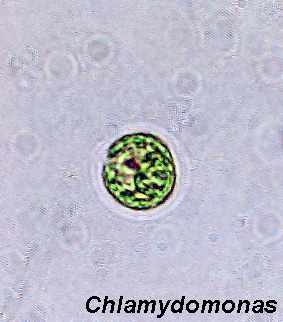UNIVERSITY OF THE WEST INDIES
BL14A - BIODIVERSITY I : THE PLANT KINGDOM
PRACTICAL 1 : ALGAE
INTRODUCTION
The algae constitute a very heterogenous group. In this practical session you will observe
and draw representative
micro- and macro- algae.
A. MICRO-ALGAE
These are algae so small they can only be seen with the aid of a microscope. Draw labelled diagrams (including a scale bar) of the SIX algal species provided. Brief descriptions of these are found below.
NOTES ON THE MICRO-ALGAL SPECIES
Blue-green 'algae'
These 'algae' (nowadays considered to be bacteria) have a distinctive blue-green colour
and in many cases carry ![]() out nitrogen fixation. Anabaena
is filamentous with each filament containing several large, thick-walled cells termed
heterocysts. These occur at regular intervals along the filament and are considered to be
important
out nitrogen fixation. Anabaena
is filamentous with each filament containing several large, thick-walled cells termed
heterocysts. These occur at regular intervals along the filament and are considered to be
important
in sporulation and are also the site of nitrogen fixation.
Euglenoids
You will encounter these in your study of the Animal Kingdom. When supplied with a food
source they no longer photosynthesize but become heterotrophs. Euglena has a single
flagellum with both ends of the cell tapering to a point.
(Photomicrograph of Euglena by H. Yoshino) 
Chlorophytes (Green algae)
| Ankistrodesmus occurs as spindle-shaped cells which may occur free or, as here, in bundles. |
 |
 |
Chlamydomonas is a green, motile, unicellular alga. Algal images courtesy of Dr. Morgan Vis |
Scenedesmus is a
coenobium of four elongated cells, joined at their long axes.
The cell walls at either end bear horn-like projections.
Chrysophytes (Golden-brown algae)
Synedra is a bilaterally symmetrical, rod-shaped diatom. The cell wall or frustule of diatoms consists of two overlapping halves (like the halves of a petri dish) and is made of silica. A slit or raphe can often be seen in the frustule.
B. MACRO-ALGAE
These are large algae, visible with the naked eye. Most are seaweeds.
Green seaweeds (Chlorophyta)
Examine the thallus of the green alga, Ulva
lactuca, the sea lettuce. Rub the frond between two fingers. What accounts for the
surface properties of this alga? Note that at the base of the frond there is a small
holdfast for attaching the plant to the substratum.
Use a small styrofoam chip as a support medium and cut transverse sections of a small
portion of frond. (See page 4, How to Cut Hand
Sections). How many cells thick is this frond?
Take a good look at the siphonous green alga, Caulerpa.
These algae show differentiation of the thallus into an erect, photosynthetic organ and a
basal 'runner' with holdfasts. Note, however, that these algae are coenocytic, i.e.
repeated mitoses have occurred without cytokinesis, so that the plant is a giant,
multinucleate unicell.
| Halimeda is another coenocytic alga but the important feature here is its extensive calcification making the plant more resistant to predation. The bright white beaches of the Pacific are often derived largely from the remains of such algae. |
Brown seaweeds (Phaeophyta)
| Padina is an unusual example of a brown alga in that it is calcified. (Calcification of algae tends more to occur in Chlorophytes.) Strengthening of cell walls by encrustation with minerals is not very common in the Plant Kingdom, occurring only in Diatoms, and higher plants like sedges, grasses and Equisetum, all of which are silicified. Growth of the Padina frond is by apical cells at the frond margin. |
Sargassum is a common seaweed of the Caribbean. It begins its life as an attached
thallus but soon becomes detached and continues life afloat, multiplying by fragmentation.
Along the branchlets are separate modified stalks bearing air bladders for floatation.
Other branchlets may bear receptacles. These may bear fertile conceptables containing
antheridia or oogonia or they may be sterile cryptoblasts containing hairs.
Red seaweeds (Rhodophyta)
| Red algae are dominant in the Tropics. They are often bleached by the sun
and so may appear green or brown. When the plants are brought into lower light intensities
or supplied with nutrients the bleached pigments are regenerated. Of this group, Gracilaria
is economically the most important. It is known in Barbados as "sea moss" and is
used to prepare various beverages and desserts. It is a rich source of agar and is
harvested commercially for this purpose elsewhere. Draw a diagram of the gross morphology of this seaweed. |
DICHOTOMOUS KEY
Devise a dichotomous key so that anyone faced with these 6 micro- and 6 macro- algae could easily distinguish them.
e.g.
| 1. Non-motile organism | 3 |
| 1. Motile organism | 2 |
| 2. Organism with single flagellum | Euglena |
| 2. Organism with 2 flagella | 4 |
etc.
To be submitted:
1. Labelled diagrams of:
(a) SIX micro-algal species
(b) Gross morphology of Ulva
(c) Hand Section of Ulva
(d) Gross morphology of Caulerpa
(e) Gross morphology of Padina
(f) Gross morphology of Sargassum
(g) Gross morphology of Gracilaria
2. Dichotomous key for distinguishing all these species as well as Halimeda.
![]()
© C.M. Sean Carrington 2000
Last revised 17 October 2000